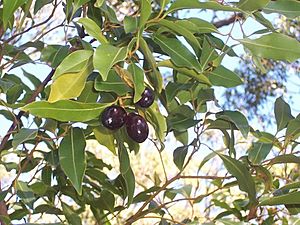Endiandra sieberi facts for kids
Quick facts for kids Endiandra sieberi |
|
|---|---|
 |
|
| Corkwood growing at Wyrrabalong National Park, Australia | |
| Scientific classification | |
| Genus: |
Endiandra
|
| Species: |
sieberi
|
Endiandra sieberi, commonly known as the corkwood tree, is a special rainforest tree found in eastern Australia. It gets its name from its unique, soft, and corky bark. This tree is an important part of the Australian ecosystem, providing food for birds and contributing to the beauty of its natural habitats.
Contents
Where the Corkwood Tree Lives
The corkwood tree is quite common in lowland rainforests and some mountain areas. You'll often find it growing on sandy soils, especially near the coast in what are called "littoral rainforests." These are forests that grow very close to the sea. The corky bark of this tree helps protect it from bushfires.
You can find the corkwood tree growing from Kioloa (which is about 35° South) near Batemans Bay in southern New South Wales. It stretches all the way up to the islands of Moreton Bay (about 27° South) in south-eastern Queensland. Besides "corkwood," people also call it hard corkwood, corkwood laurel, and pink corkwood.
What the Corkwood Tree Looks Like
The Endiandra sieberi is a medium-sized tree. It can grow up to 30 metres (about 98 feet) tall. Its trunk can be as wide as 90 centimetres (about 3 feet) across.
Bark, Trunk, and Leaves
The bark of the corkwood tree is a fawnish-grey colour. It feels quite soft and corky. Very large trees might have slightly wider bases, but they don't have big, spreading roots like some other trees. The main trunk is usually straight and round.
The leaves grow in an "alternate" pattern, meaning they don't grow directly opposite each other on the stem. They are simple, meaning each leaf is a single blade, and "entire," meaning their edges are smooth without any teeth or lobes. The leaves are usually 5 to 8 centimetres (about 2 to 3 inches) long. They narrow down to a blunt point at the end. The top of the leaf is mid-green, while the underside is a lighter green. The stalks that hold the leaves are about 5 to 10 millimetres (less than half an inch) long.
The main vein (midrib) of the leaf sticks out a little on the top side but is flatter underneath. You can clearly see the network of smaller veins, similar to another tree called Cryptocarya microneura. The midrib itself is a creamy yellow colour.
Flowers, Fruit, and Growing New Trees
The corkwood tree produces flowers from June to October. These flowers are usually cream or yellow in colour. They grow in clusters called "panicles," which are branched groups of flowers.
The fruit of the corkwood tree is a type of "drupe," which is a fleshy fruit with a hard pit or stone inside, like a peach or a cherry. The fruit is egg-shaped, black, and shiny. It is about 2 to 3.5 centimetres (about 1 to 1.4 inches) long. Inside, there's a single seed that is oval and pointed, about 25 to 30 millimetres (about 1 to 1.2 inches) long.
Rainforest birds, including the white-headed pigeon and the topknot pigeon, love to eat these fruits. The fruits are ripe and ready to be eaten from March to October.
To help the seeds grow, it's a good idea to remove the fleshy outer part of the fruit, called the "aril." This is a common tip for growing most Australian "laurel" tree seeds. After planting, the roots and shoots usually start to appear within three to twelve months. About 20 percent of the seeds will successfully grow into new trees.
Timber and Its Uses
The wood from the corkwood tree is light in colour, hard, and has a fine grain. A long time ago, when Australia was first being settled, people tried to use the bark of the corkwood tree as a substitute for cork. However, it wasn't as good as the cork from the cork oak tree, which is where most cork comes from.
Gallery
-
Corkwood growing at Wyrrabalong National Park, Australia
-
Corkwood bark, growing at Chatswood West
-
30 metre tall Corkwood growing by the Hacking River, Australia
-
30 metre tall Corkwood growing by the Hacking River, Australia
- Floyd, A.G., Rainforest Trees of Mainland South-eastern Australia, Inkata Press 1989, ISBN: 0-909605-57-2
See also
 In Spanish: Endiandra sieberi para niños
In Spanish: Endiandra sieberi para niños









